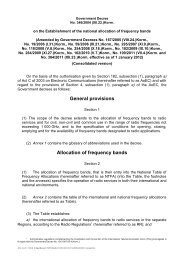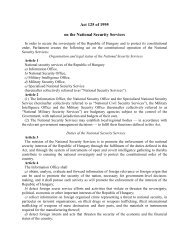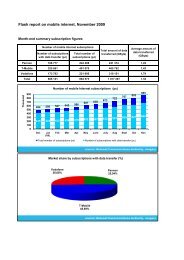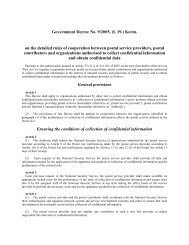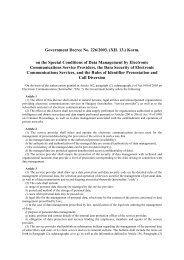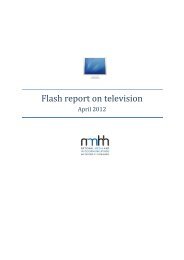The Hungarian Communications Market Developments and ...
The Hungarian Communications Market Developments and ...
The Hungarian Communications Market Developments and ...
You also want an ePaper? Increase the reach of your titles
YUMPU automatically turns print PDFs into web optimized ePapers that Google loves.
02 03<br />
years. This year one of NHH’s focus areas is to increase consumer<br />
awareness, which – after revision of the EU regulatory framework – will<br />
become a key issue at a European level, too.<br />
With Hungary’s accession to the EU in 2004, market definition <strong>and</strong><br />
market analysis conducted pursuant to the Act on Electronic Communication<br />
<strong>and</strong> the EU Framework Directive became the very basis<br />
of regulation for NHH. Along precisely defined rules of procedure,<br />
we commenced analyses in 18 markets, mapped market anomalies,<br />
identified service providers with significant market power <strong>and</strong> established<br />
the commitments to remedy market failures. We have already<br />
conducted two comprehensive market analyses involving the entire<br />
market <strong>and</strong> in both cases were one of the first European authorities to<br />
complete such analyses. At the end of 2008, we were at the stage of<br />
the first decision regarding a third round of analyses. It is of symbolic<br />
importance that this decision involves the termination rates of mobile<br />
service providers, an item provoking heated debates both in the EU<br />
<strong>and</strong> ERG of European regulatory authorities.<br />
With its decision aiming to create a predictable situation for three<br />
years, NHH committed itself as early as in 2006 to the symmetry <strong>and</strong><br />
significant reduction of termination rates. Mobile termination rates<br />
fell by some 40 percent since 2004 to universally become as low as<br />
HUF 16.84 per minute by 1 January 2009. Our goal is to maintain this<br />
reduction rate also in the years to come. Although our decisions on<br />
termination rates <strong>and</strong> other key market issues were welcomed by the<br />
market as a whole, they were underst<strong>and</strong>ably not always appreciated<br />
by the service providers thus affected. <strong>The</strong>ir objections led, in many<br />
cases, to court procedures. Nevertheless, not a single court decision<br />
of legal effect has been made to date to dispute such decisions of the<br />
Board of NHH.<br />
Perhaps some readers remember the 2004 introduction of third<br />
generation mobile services, also known as the UMTS tender in Hungary.<br />
As a result of the tender procedure administered by NHH, all of the<br />
three former mobile telephone service providers obtained the required<br />
rights to frequency use, with the state making a profit of nearly HUF<br />
60 billion, which was beyond expectations. A few years later, upon<br />
the extension of the GSM concessions in 2007, both Pannon <strong>and</strong><br />
T-Mobile/Magyar Telekom undertook broadb<strong>and</strong> development worth<br />
another HUF 20 billion each within two years, in addition to their HUF<br />
10 billion budget payment. <strong>The</strong> promotion of the spread of broadb<strong>and</strong><br />
Internet is one of the key issues at authority, state <strong>and</strong> user levels,<br />
both in Hungary <strong>and</strong> in the EU. It is of enormous significance for the<br />
competitiveness of individuals, the country <strong>and</strong> the continent to bridge<br />
the still existing digital divide <strong>and</strong> to enhance digital literacy.<br />
While third generation mobile services have given boost to the<br />
<strong>Hungarian</strong> market <strong>and</strong> a fierce competition has developed in the<br />
market of wireless Internet between the three domestic service<br />
providers, an important reason behind the announcement of the<br />
current tenders is that the intensity of such competition has recently<br />
somewhat declined. <strong>Market</strong> shares did not change much for months,<br />
<strong>and</strong> even prices stopped to decline. According to our expectations,<br />
a potential fourth service provider <strong>and</strong> the introduction of a<br />
new business model would give another boost to the otherwise well<br />
performing mobile market. In addition to enhancing competition in<br />
the mobile market, the promotion of the spread of broadb<strong>and</strong> Internet<br />
is also important. This field is currently characterised by three<br />
competing technologies – traditional DSL, cable modem access <strong>and</strong><br />
wireless – which is a favourable situation.<br />
As a result of a number of regulatory measures, there is competition<br />
in the DSL market in the area of all incumbent service providers, with<br />
efficiently operating alternative service providers becoming increasingly<br />
more serious competitors to former providers with monopoly.<br />
Cable television service providers with very high penetration rates in<br />
Hungary have also engaged in this competition <strong>and</strong> grown to be major<br />
challengers of fixed-line service providers in the field of both voice <strong>and</strong><br />
Internet services. Such competition was further strengthened by wireless<br />
service providers, including the three mobile service providers,<br />
with all this leading to a fast increase in Internet coverage <strong>and</strong> an even<br />
faster reduction of prices. Today, no further significant increase in Internet<br />
penetration is hindered either by coverage or price factors. We<br />
have also taken several regulatory measures to increase the coverage<br />
of the few still unserviced areas.<br />
A tender procedure is aimed at re-introducing the 450 MHz frequency<br />
range to the market, as this range is perfectly suitable for establishing<br />
efficient broadb<strong>and</strong> coverage in sparsely populated areas.<br />
By using the 26 GHz frequency range, we also intend to facilitate the<br />
cost-effective development of service providers’ own infrastructures.<br />
<strong>The</strong> cooperation between service providers already in the market <strong>and</strong><br />
those striving to enter the market must definitely be improved. <strong>The</strong><br />
invitation to tender expressly encourages existing service providers to<br />
assist new ones in their entry into the market, which therefore allows<br />
new service providers to submit part of the frequencies awarded<br />
to any incumbent service provider in exchange for the possibility of<br />
domestic roaming. We expect this model to give a new impetus to the<br />
market <strong>and</strong> to contribute to the efficient <strong>and</strong> cost-effective utilisation<br />
of the country’s frequency spectrum.<br />
Besides electronic communications, NHH’s activities also extend<br />
to areas such as postal services, IT <strong>and</strong>, to a certain extent, the<br />
media. In 2008, we were successful in managing the tendering<br />
procedure required for the launch of terrestrial digital free-to-air<br />
broadcasting. Terrestrial digital television <strong>and</strong> radio services are being<br />
launched these days, with their success becoming measurable




